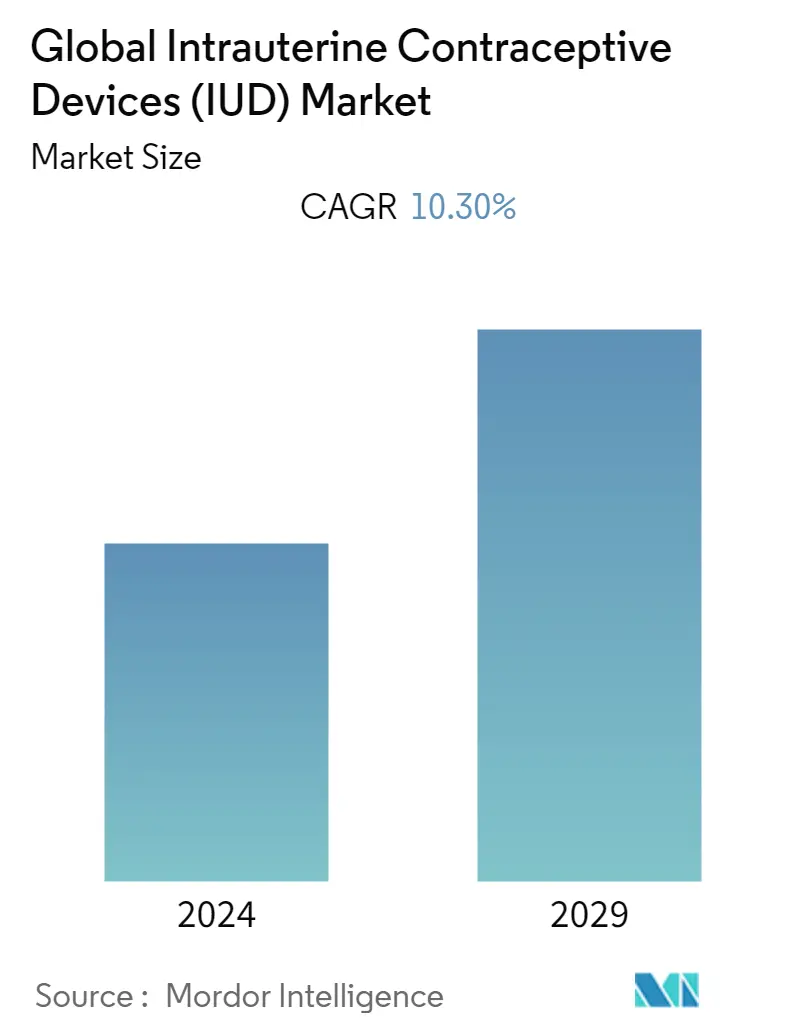Market Size of Global Intrauterine Contraceptive Devices (IUD) Industry

| Study Period | 2019 - 2029 |
| Base Year For Estimation | 2023 |
| Forecast Data Period | 2024 - 2029 |
| CAGR | 10.30 % |
| Fastest Growing Market | Asia Pacific |
| Largest Market | North America |
Major Players
*Disclaimer: Major Players sorted in no particular order |
Need a report that reflects how COVID-19 has impacted this market and its growth?
Intrauterine Contraceptive Devices Market Analysis
The Intrauterine Contraceptive Devices (IUD) Market is expected to register a CAGR of 10.3% over the forecast period.
During the COVID-19 pandemic 2020 and increasing cases of COVID-19 worldwide, the health care emphasis has shifted to focus on the apportionment of resources, prevention of viral spread, emergent medical care, and the development of novel treatments and vaccines. Moreover, the unfortunate byproduct of this shift is the de-prioritization of other essential health care services such as access to contraception.
According to a resarch study by Anita Makins et al., published in Gynecology & Obstetrics Journal May 2020, during the COVID-19 pandemic 2020, there was an impending stock-outs of contraceptive methods which are about to ensue. Moreover, United Nations Population Fund (UNFPA) estimates that during the next six months from May 2020, 46 countries that usually receive supplies from them will experience stock-outs of one or more modern methods, including copper intrauterine devices, implants, depot medroxyprogesterone acetate (DMPA) intramuscular (IM) and subcutaneous (SC), oral contraceptive pills (combined and progestin only) and condoms.
In addition, according to the research study by Aisha Dasgupta et al., published in Gates Open Research November 2020, globally, it had been estimated that 77% of women of reproductive age (15-49 years) would have their need for family planning satisfied with modern contraceptive methods in the year 2020. However, taking into account the potential impact of COVID-19 on method-specific use, this could fall to 71%, resulting in around 60 million fewer users of modern contraception worldwide in 2020.
The major factors for the growth of the intrauterine contraceptive devices (IUD) market include the technological innovations leading to effective contraception and fewer side effects, increasing rate of unintended pregnancies, and supportive government initiatives and private firms for the prevention of unwanted abortions and pregnancies.
Unintended pregnancy is an undesired conception. Not using contraception or incorrect use of contraceptive methods can result in unintended pregnancy. The percentage of unintended pregnancies is highest in teens younger than 18 years, followed by women in the age group of 20 to 24 years. These unintentional pregnancies are directly contributing to the raised demand for contraceptive devices.
Moreover, the number of unwanted pregnancies are increasing, and this has become one of serious concerns, globally. For instance, according to World Health Organization (WHO), unintended pregnancies have been an important public health issue. Globally, about 22 million unsafe abortions were estimated to take place each year, which result in the death of an estimated 47,000 women, as per the International Federation of Medical Students' Associations 2018 report.
However, over the past few years, the awareness of contraception has contributed to both the decline in unplanned pregnancies and the growth of the contraception market. Family planning efforts, which include increasing access to intrauterine contraceptive devices, can help reduce unintended pregnancies. The use of IUDs decreased the proportion of births that were unplanned. The usage of IUD is increasing year on year as women find IUD the most convenient, safe, and effective form of contraception.
For instance, according to a research study by Ghzl Ghazi Alenezi et al., published in Middle East Fertility Society Journal April 2021, the study results found that most women in urban Hail community, northern Saudi Arabia, were aware about and have a positive attitude towards family planning. About two-thirds of population were currently using any contraceptive method/s, which is higher than the national estimate for Saudi Arabia. Therefore, the market studied is expected to be driven by the increasing unintended pregnancies, worldwide. However, factor such as risk of causing pelvic inflammatory infection (PID) is likley to impede the market growth in near future.
